The Article
Disco-Antistat Vinyl Cleaning Machine From Knosti
11th September 2020
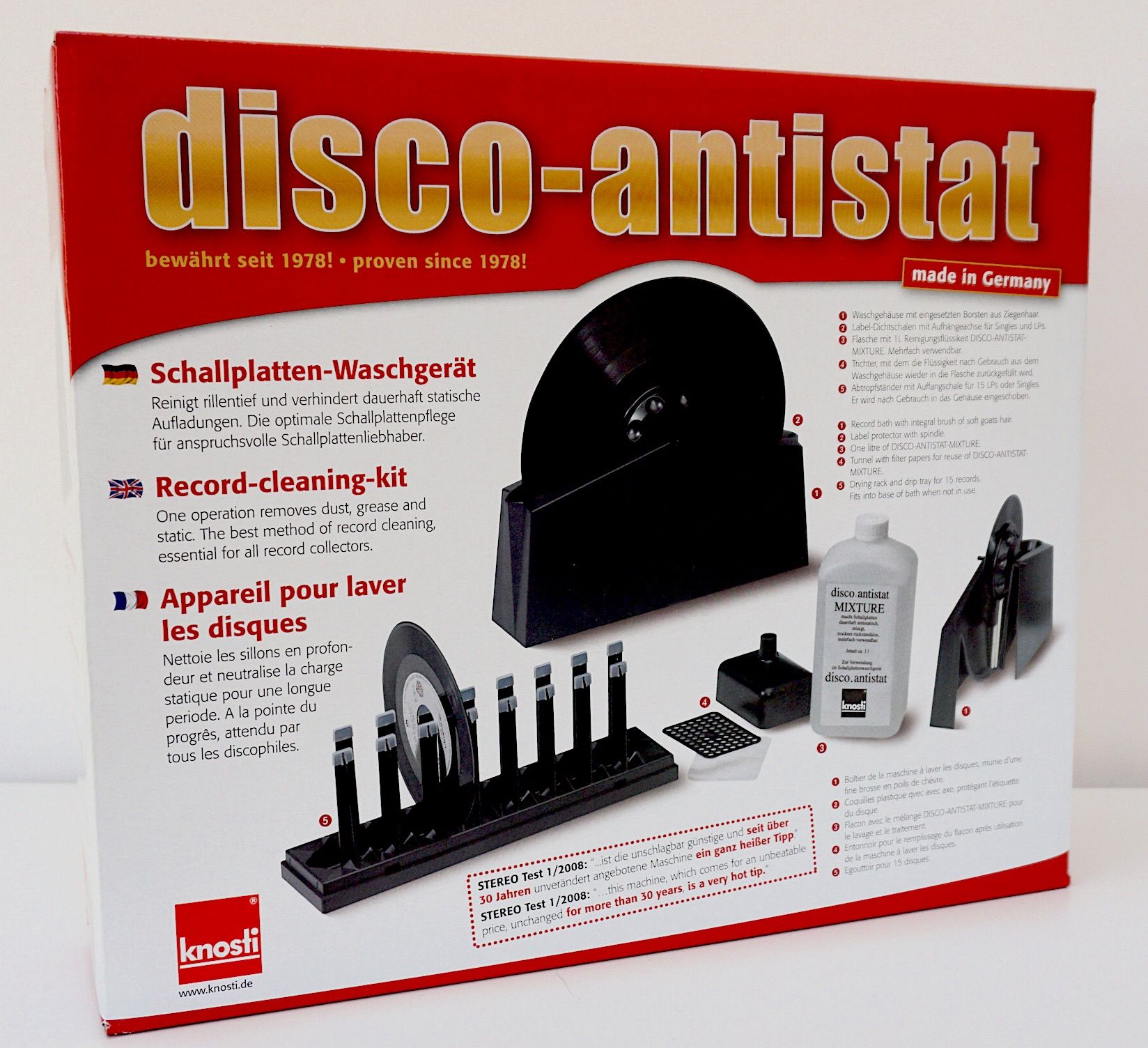
Offering a low-cost, manual vinyl cleaning solution, Paul Rigby readies his records for a quick wash and brush up
Blimey, we vinyl fans have a complex relationship with our records. Just look at one aspect of the relationship, cleaning the darned things. There are a host, a gamut of methods to clean vinyl discs. This format must be unique in offering so many cleaning solutions and so many complex ways to do it. I’ve never known so much effort to be placed into, what seems to be, a simple task.
Yet cleaning vinyl isn’t a simple task. If only it was, our lives would be so much simpler. Nevertheless, there is an odd sense of achievement, even fulfilment when you know that, not only have you cleaned your record well but the result of your hard efforts, has actually improved the sound quality to boot.
Spending serious time cleaning your vinyl collection brings with it solid, sonic rewards and thus is worth the time and effort involved.
I would say that vinyl cleaning is divided into three main categories: manual cleaning, cleaning via a RCM (Record Cleaning Machine) based upon a vacuum system and the high-end option, the ultrasonic cleaner.
Of course, as you might expect, manual cleaning is the cheapest option but often it’s the choice fraught with the most pitfalls. Mainly because this budget sector is filled with vinyl zealots who verge on the insane, cranks, conspiracy theorists, the militant and the downright weird. And that’s just my friends I’m talking about. Never mind everyone else. You don’t know who to believe, half the time. Some independent cleaning solutions seem guaranteed, not to clean you records, but melt them into a waxy lump
It’s a category filled to the brim with cleaning products that I wouldn’t touch with a barge pole. Its also a category that is filled with a plethora of home-brew options, urban myths and “recommended” cleaning solutions that are so scary to watch or hear about, they would give Edgar Allan Poe goosebumps.
More reliable manual record cleaning solutions still present a busy area though. It can be achieved by the use of different types of brushes, felt pads, gizmos and more with the help of a 1001 different liquid concoctions.
This is one of those proposed cleaning solutions. A cleaning machine that arrives with its own cleaning liquid. It’s been around for some time, I realise but I’ve never properly reviewed it. I thought it was about time.
This entry into the manual-cleaning field comes from Germany and has the wholly terrible name of Disco-Antistat. It’s true, I’ve never known such a poor appellation for any product of any stripe in my entire life.
That said, it’s a name you tend to remember. So…maybe that’s the point?
Arriving in a colourful yet solid box, the contents are neatly arranged, packed with plastic but again, feel solid and sturdy. There’s nothing overly flimsy in terms of structure and design here. Looking and handling the bits and pieces in the box, you feel that you’re getting your money’s worth.
INSTALLATION & USE
The parts are simple to use and the system is relatively easy to install. Out of the box, you will find the largest part, the bath. A one-piece structure. This is the part that will ultimately support the record while cleaning too. It’s easy to miss the fact that a drying rack is tucked ingeniously inside this bath. Turn the bath upside down and you will see the drying rack slotted underneath, pull that out and place it to one side for now.
Other parts include a two-part clamp and funnel-filter. We’ll get to the funnel in a moment. One half of the clamp includes a bayonet axle. This axle pushes though the record’s centre spindle hole, the other side of the clamp screws over this axle while the vinyl record forms the meat in the sandwich.
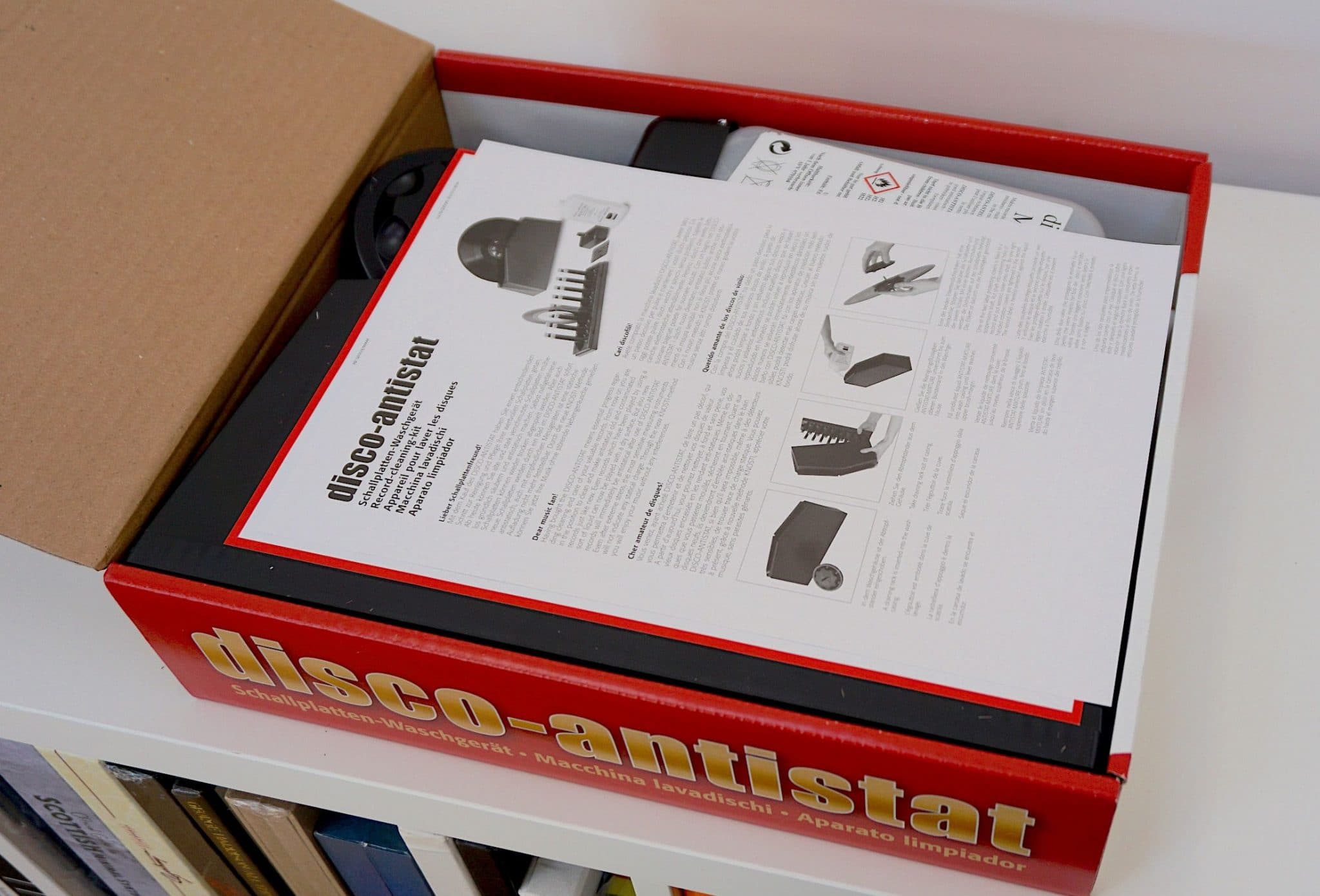
Both sides of the clamp can then be screwed to tighten. You’ll find that one side of the clamp tightens in a clockwise fashion and the other in an anti-clockwise manner which makes adding and removing the clamp easy to do.
Once the clamp is securely on the the record, you will notice that the clamps provide two services.
Firstly, there are two outer axle ends that fit into the bath runnels that allow you to rotate the record while on the bath to facilitate cleaning. Secondly, with the clamp in place, note how the clamp itself covers the record label, keeping it dry during the cleaning process. Simple yet effective.
To clean, you add the supplied cleaning liquid, which has already been diluted and is ready to use, to the bath (I’ll talk more about the liquid later on). The manufacturer wants you to pour enough liquid until the level reaches the uppermost part of the brush. I would advise against that otherwise you risk running too close to the label area. I know the label is protected by the clamps but, even so, I wouldn’t tempt providence here.
That said, I’d do a dry run, if you can, for each and every record you clean in case there are variations in label position and size. See below for advise on storing the bath liquid elsewhere while you do this. On average, I would suggest leaving about half a centimetre of brush poking out of the liquid. That is, have half a centimetre of brush exposed and dry before you see the uppermost level of bath liquid.
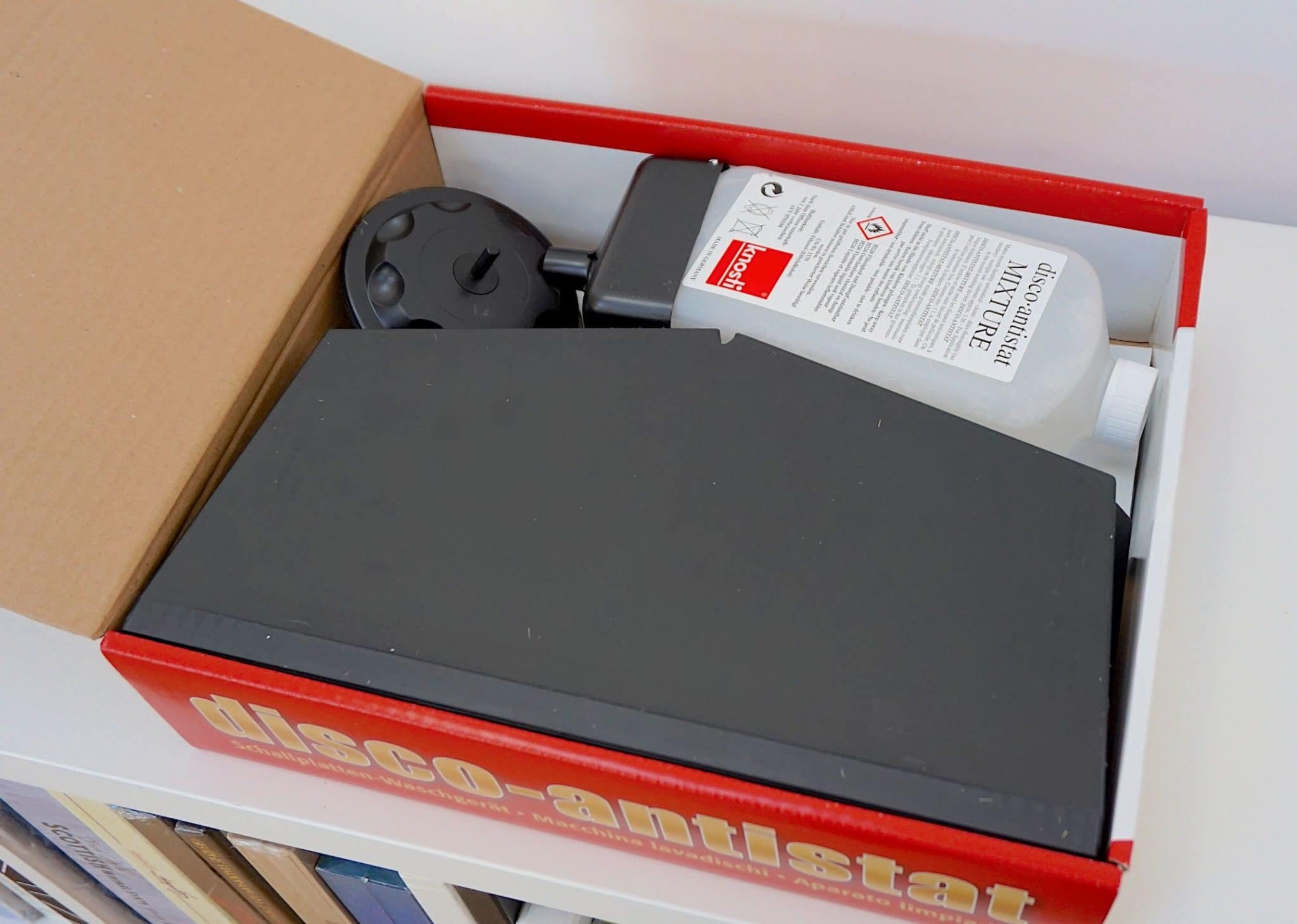
You insert the record into the bath itself. The clamp provides full support. Then you rotate the record manually to clean.
The instructions are a bit on the wishy-washy side (no pun intended) when it comes to just how many rotations you need but, during tests, I found that six full rotations to the right are sufficient. When completed, reverse your direction. Complete another six rotations in the opposite direction and you’re sorted. Rotating the record in this manner allows the brushes to attack the groove grime from both directions, encouraging stubborn muck to be dislodged. You may require multiple cleanings, depending on the state of the record.
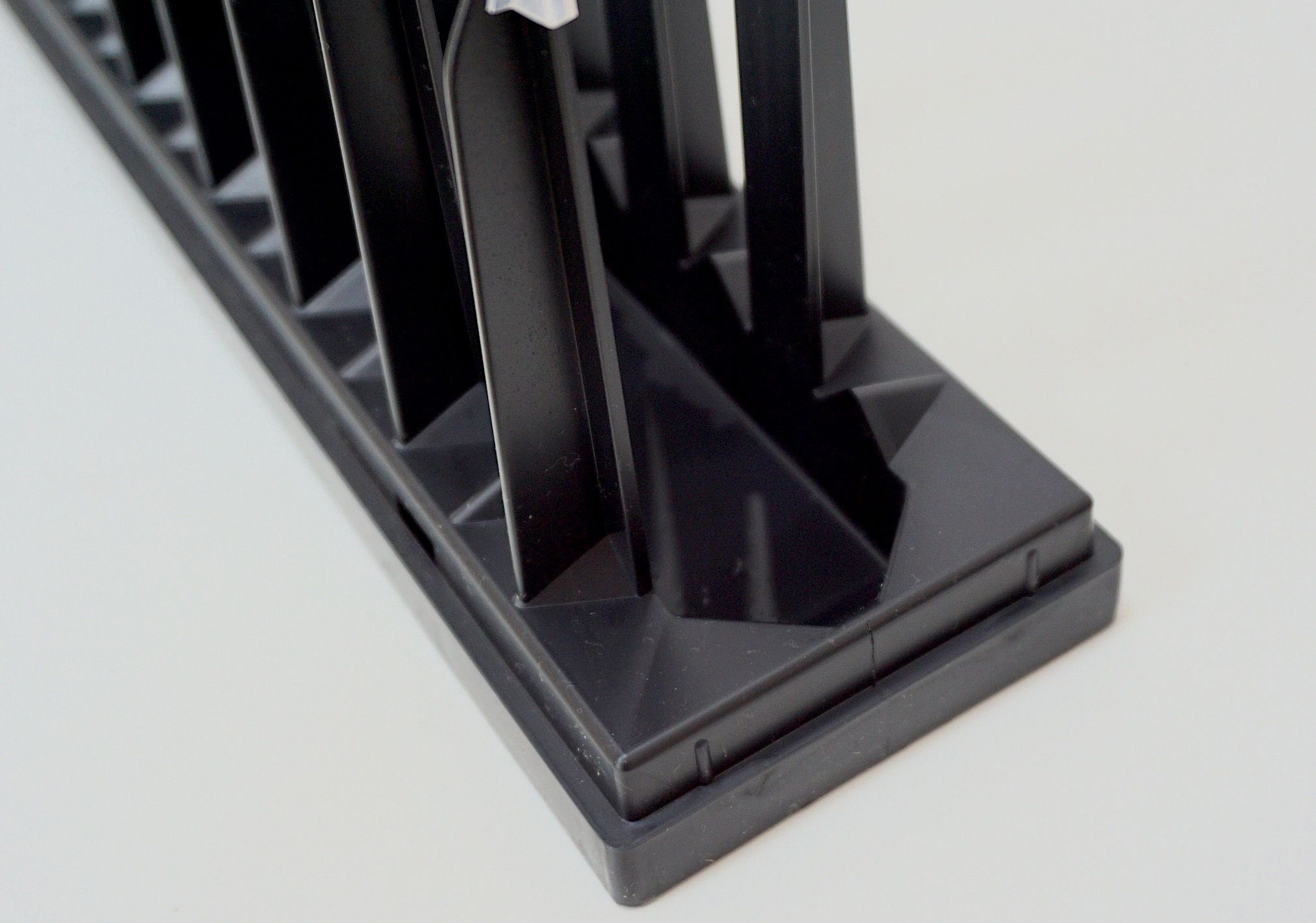
You need to then partially lift out the record by its clamp axles. Not all the way, allow liquid run-off to escape back into the bath and then twist off the clamp to remove it. Place the wet record vertically on the rack which will support the record featuring, as it does, a set of non-scratchy plastic pieces on the ends of each rack prong. Liquid excess will drip (from which it will no doubt eventually evaporate) into a channel cut out at the bottom of the rack.
Then you need to grab a coffee and wait for the record to dry.
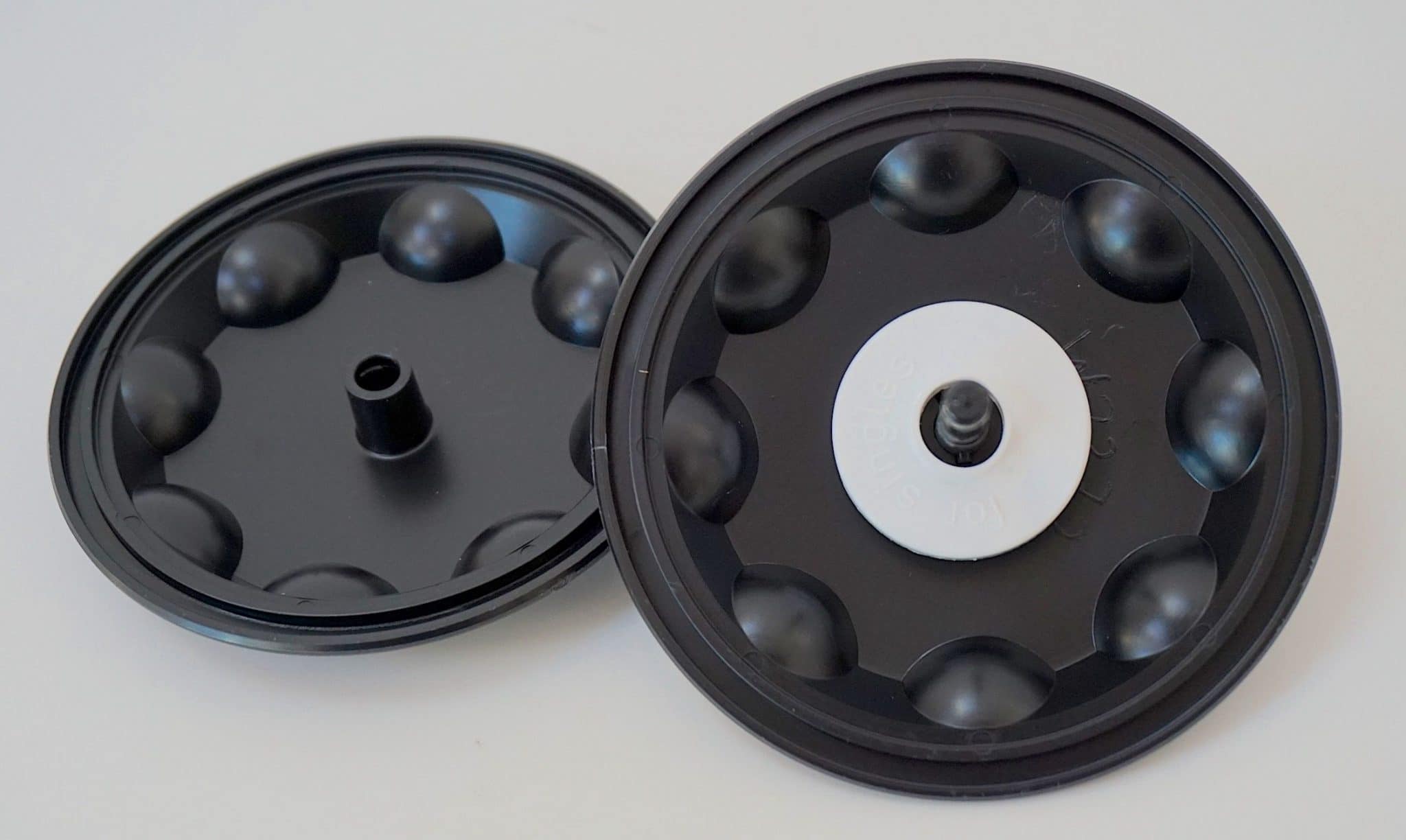
According to the instructions, you then place a filter in the supplied funnel, put the end of that in the end of the cleaning liquid bottle and return the bath liquid to the bottle while any muck will be trapped in the filters.
Really? It’s too much hassle and I wouldn’t bother. Depending on the grimy nature of your records, I would use the bath liquid until its too contaminated to use, and then dispose of the same. Then refill with new liquid. In between, to prevent airborne contamination, by all means cover the bath with a cloth or, a better alternative, shape a large piece of kitchen foil over the bath entrance which will be spotlessly clean (a cloth might not be), can be shaped into a rough bath shape and has an element of rigidity and weight so will stay put when the Disco-Antistat is not in use.
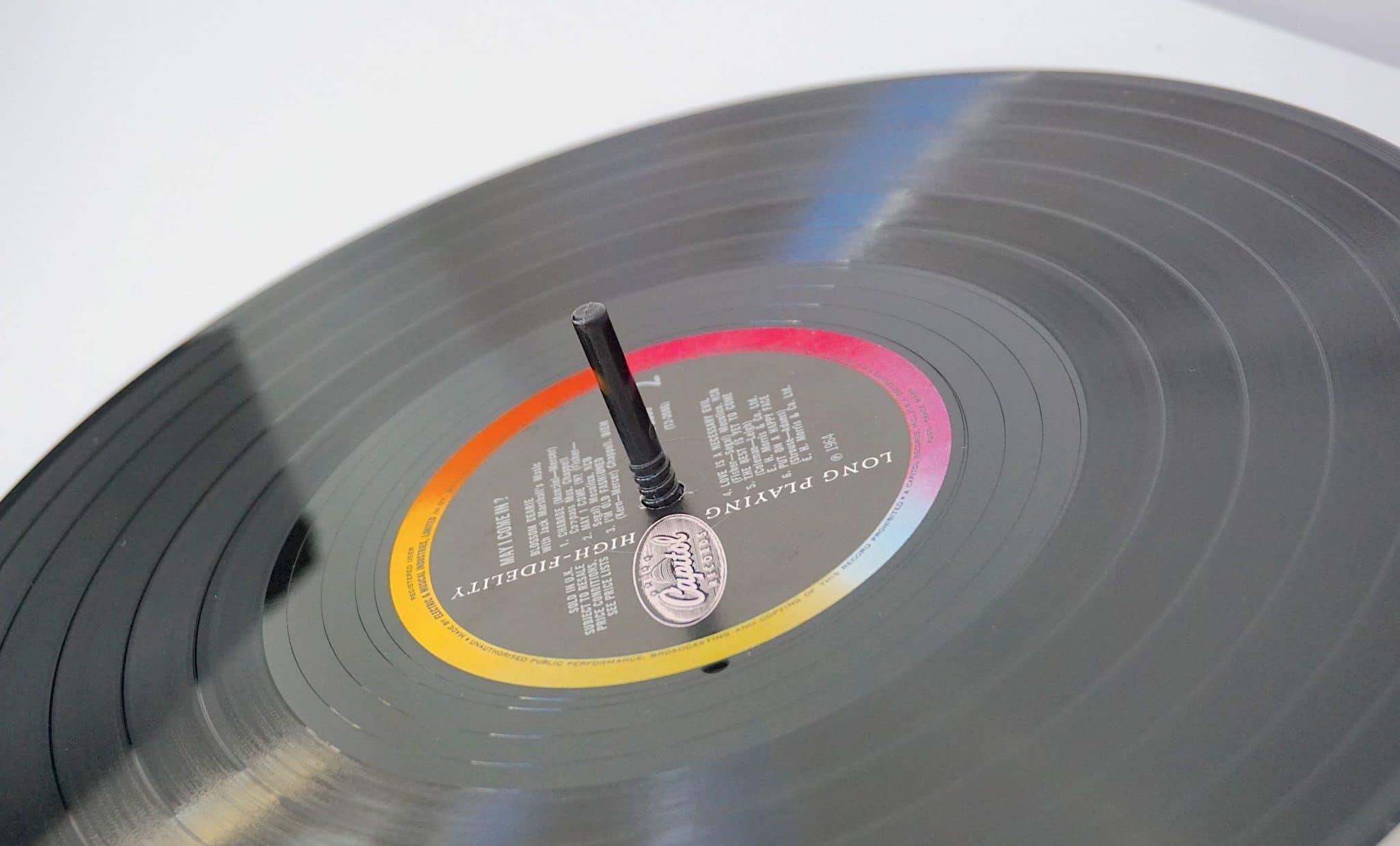
By all means use the funnel/filter combo as an interim cleaner but place the funnel over your own, seperate container such as a cleaned bottle and then pour the newly filtered liquid back into the Disco Antistat’s bath, cover and you’re done. If you do take this path, make sure you clean your temporary container bottle or somesuch and then swill it twice over with distilled water to remove any hidden impurities. Then cover the container when not in use. Again, foil is a good choice because a cloth can deposit tiny dusty bits, lint and the like.
SOUND QUALITY
I began with a tough cleaning task. I didn’t want to mess around here. Tough because this record – Barclay James Harvest’s Time Honoured Ghosts (Polydor) – exhibited none of the usual dirty record characteristics of snap, crackle and pop. Play was silent. The music sounded good. Yet, I wanted to see if the Disco Antistatic could improve the sound from that point. This record had never been cleaned by myself so I wondered if there was room for improvement.
Any by gum there was, absolutely. The improvements were stark, immediate and wide ranging.
Principally, the soundstage hit me first. It now sounded larger, wider, higher and definitely more spacious. The amount of space in and around the soundstage really allowed the band to roam now. In contrast, the soundstage sounded claustrophobic before the Disco-Antistat cleaned the record. Also the lead vocal had a slight edge, an unpleasant upper midrange attack that made listening at high volumes uncomfortable. That had gone now. After the clean, the lead vocal was balanced in its presentation but there was more than that. The ear could better pick up the contrasting reverb hanging off the lead vocal and the backing harmonies. The latter was drenched in the stuff while the lead vocal was drier and now detached from the band. This sort of subtle detail was always there but the Disco-Antistat clean had made the effect more obvious. The ear had to work less to catch the effects, basically.
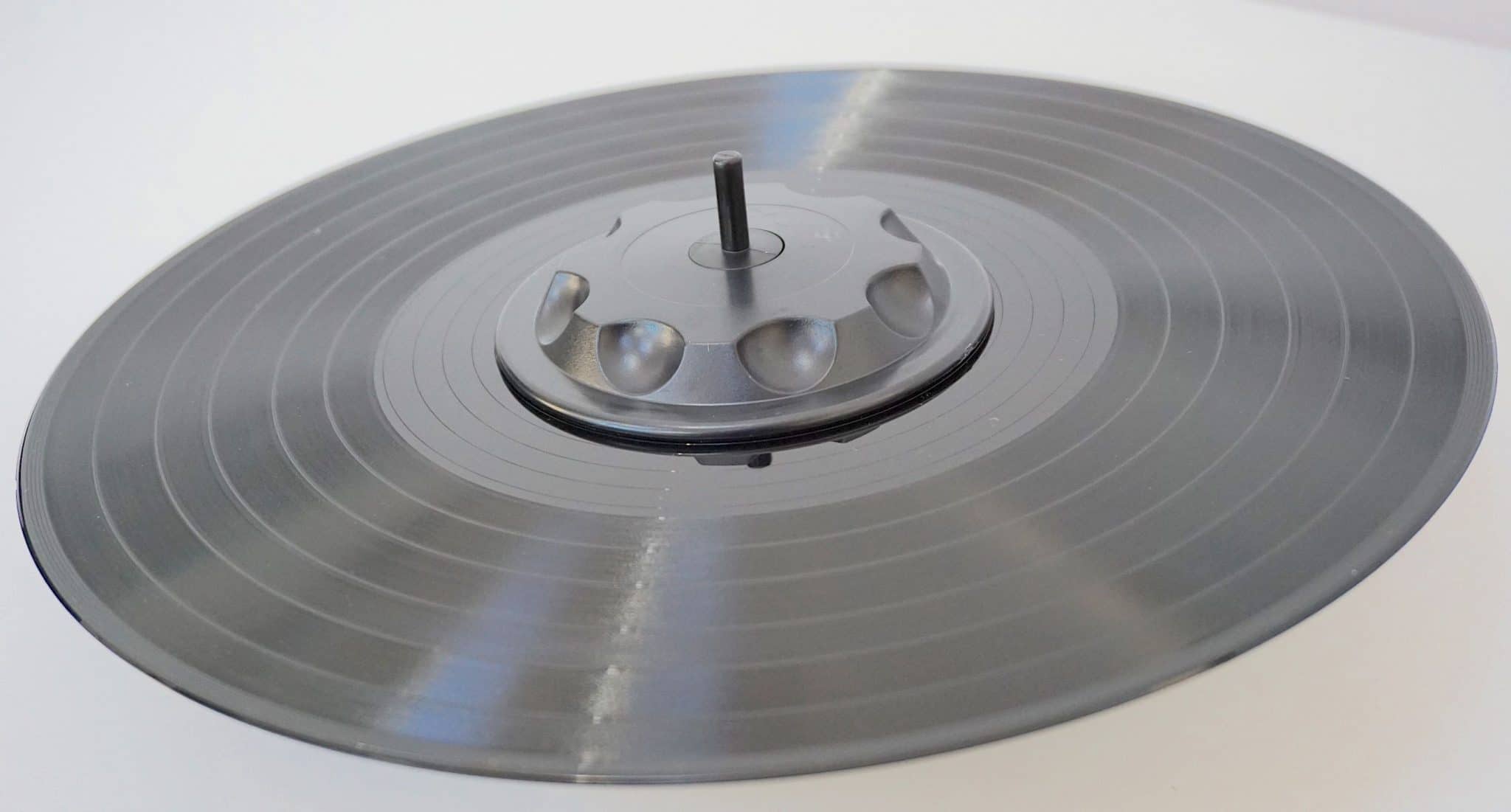
Instrumentally, bass offered more character and tonal accuracy while new detail emerged from the guitars. In fact, a rhythm guitar was pushed further forward into the mix, adding rich layering to the music.
During cleaning, what I loved about the mechanical process was the inclusion of the brushes themselves. I hear that these are goat-hair brushes which offers enough stiffness to get deep into the grooves.
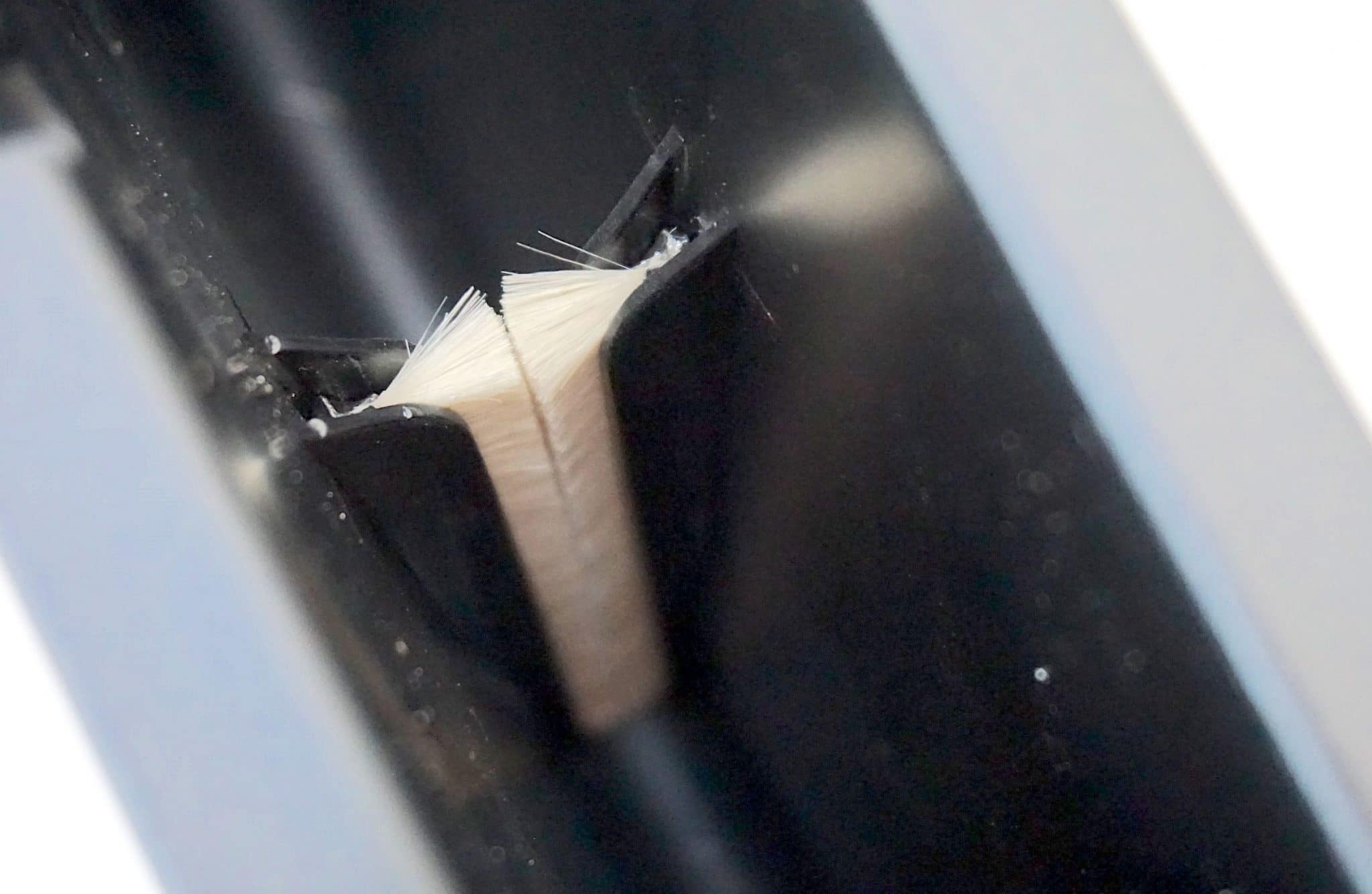
It’s these brushes that are, for me, the stars of the Disco-Antistat show. The general design is a good one. It’s simple to use. Sure the cleaning liquid helps a lot to help remove muck and grime but there is a certain degree of attrition (of a gentle nature of course, but still…) from the brushes that helped to remove as much baked-on oil from the groove walls and floor as possible. This is the oil that naturally leaches from within the vinyl itself and serves as the mythical ‘release agent’ to aid extraction from the record press. Because its never properly removed though, it tends to harden over time and it’s tough to remove in its entirety. It’s the latter that is the toughest obstacle to eradicate from any groove and these brushes do a great job in that respect. Certainly in terms of the price you pay. Attrition is a much neglected subject when vinyl cleaning is discussed but it’s critical, absolutely critical to successfully clean your records. The Disco-Antistat is actually one of the very few cleaners out there that accommodates this cleaning action type.
VS THE SPIN CLEAN?
Using my sound tests, its attritional abilities is also why I rate the Disco-Antistat above competitors like the more expensive Spin Clean Record Washer which, instead of a set of brushes, relies on pads to do the scrubbing. Pads just don’t cut it in cleaning terms. Strike that, they’re ok. Just not wonderful. They offer little or no attrition.
I performed a direct A-B comparison between the Disco-Antistat and the Spin Clean system, which looks very smart but uses those pads I mentioned instead of the brushes and the resultant cleaning performance was easy to hear. The Disco-Antistat was ahead in terms of sonic improvement.
Testing both jazz and rock, the Disco-Antistat produced a transparent output, more space in the soundstage than the Spin Clean. The Spin Clean produced improvements across the frequency spectrum, sure. It did improve the sound but I wanted more. The Disco-Antistat did go further in the production of a higher degree of reverb-infused, fragile moments like cymbal taps, for example.
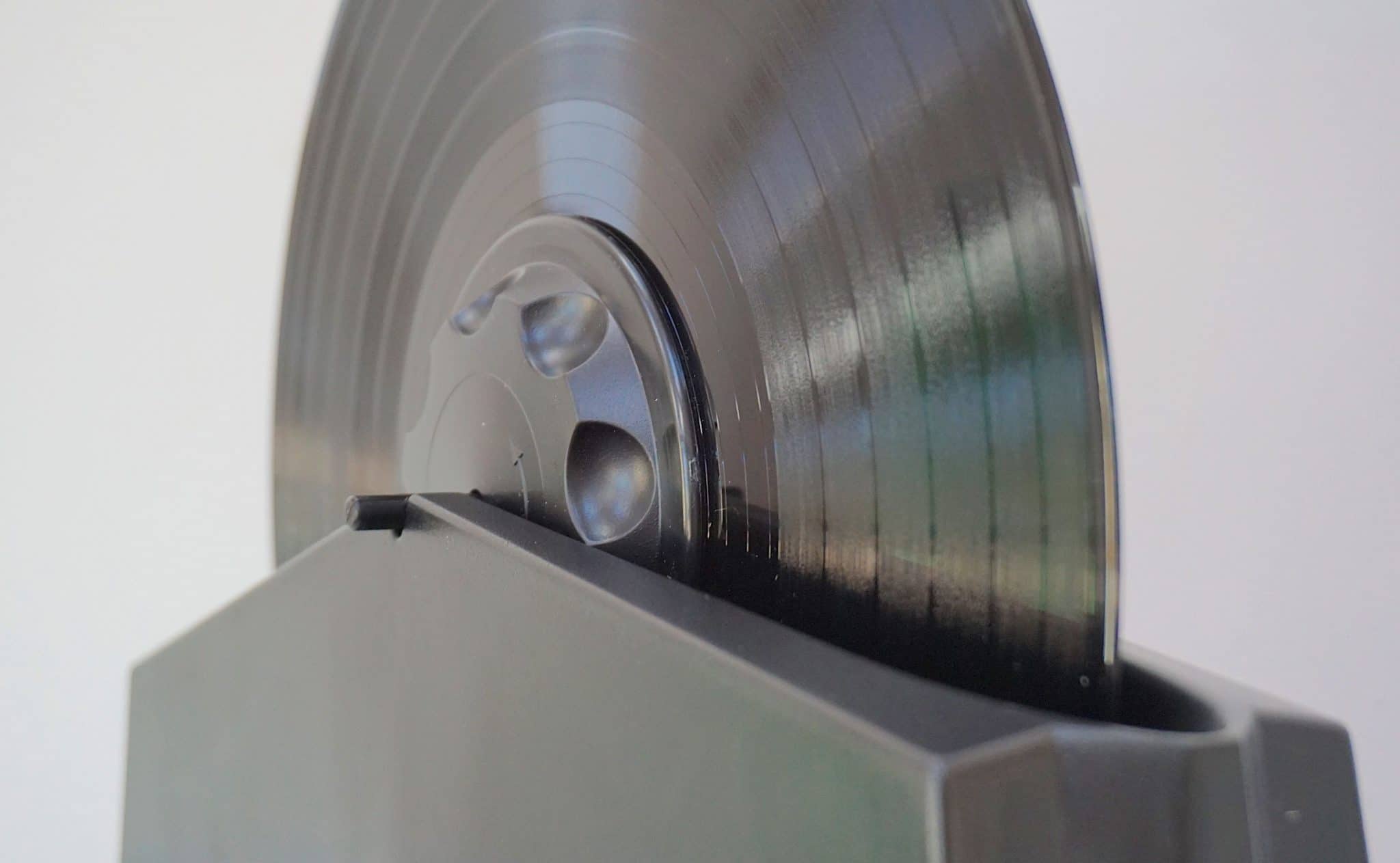
To repeat, the Spin Clean did do an admirable job. It’s not bad, in any way. It’s just that the Disco-Antistat is a better cleaning system. Again, point at the brushes for the reason for that.
DEPOSITS
I did have an issue with the Disco-Antistat liquid, though. Nothing sonic. More physical, I suppose. I have used the Disco-Antistat liquid in the past and I’m reviewing it now. And now, just as then, the liquid forms a deposit on the stylus as it plays. Which means that you’re constantly cleaning your stylus after every side of vinyl play. You can even see a build up after one single album track is played through. After cleaning my stylus, I repeated the play process. Same side, same LP and yes, there was more residue stuck to the stylus which demanded another clean. Which is irritating.
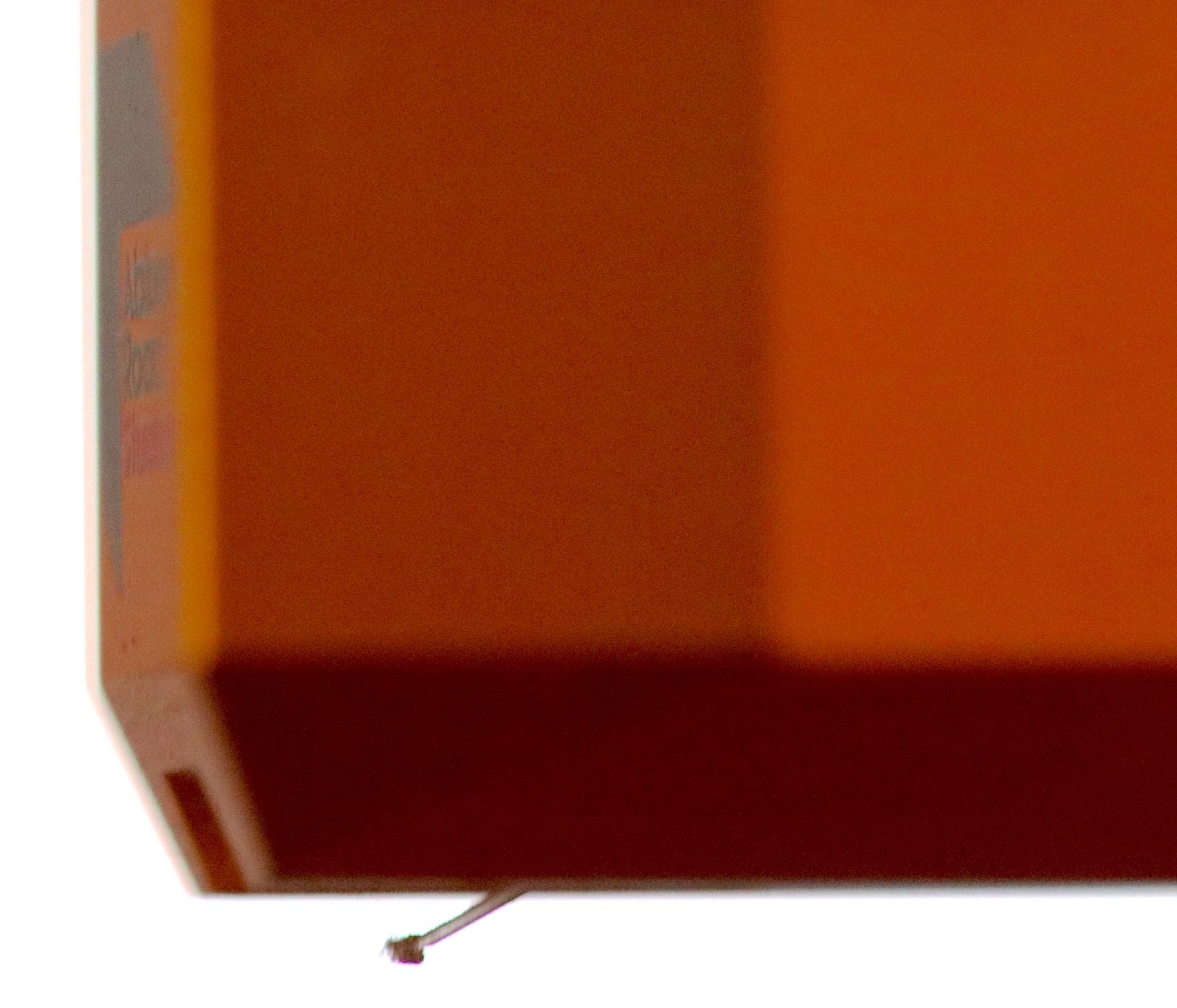
More than that, if your stylus is scooping up a residue off the groove walls and floor then that means the stylus is not as close to the vinyl itself and may very well be ‘playing’ the Disco antistatic liquid.
Just how many times would I have had to allow my stylus to run through these grooves before this residue stopped collecting? I wasn’t going to find out. Action needed to be taken.
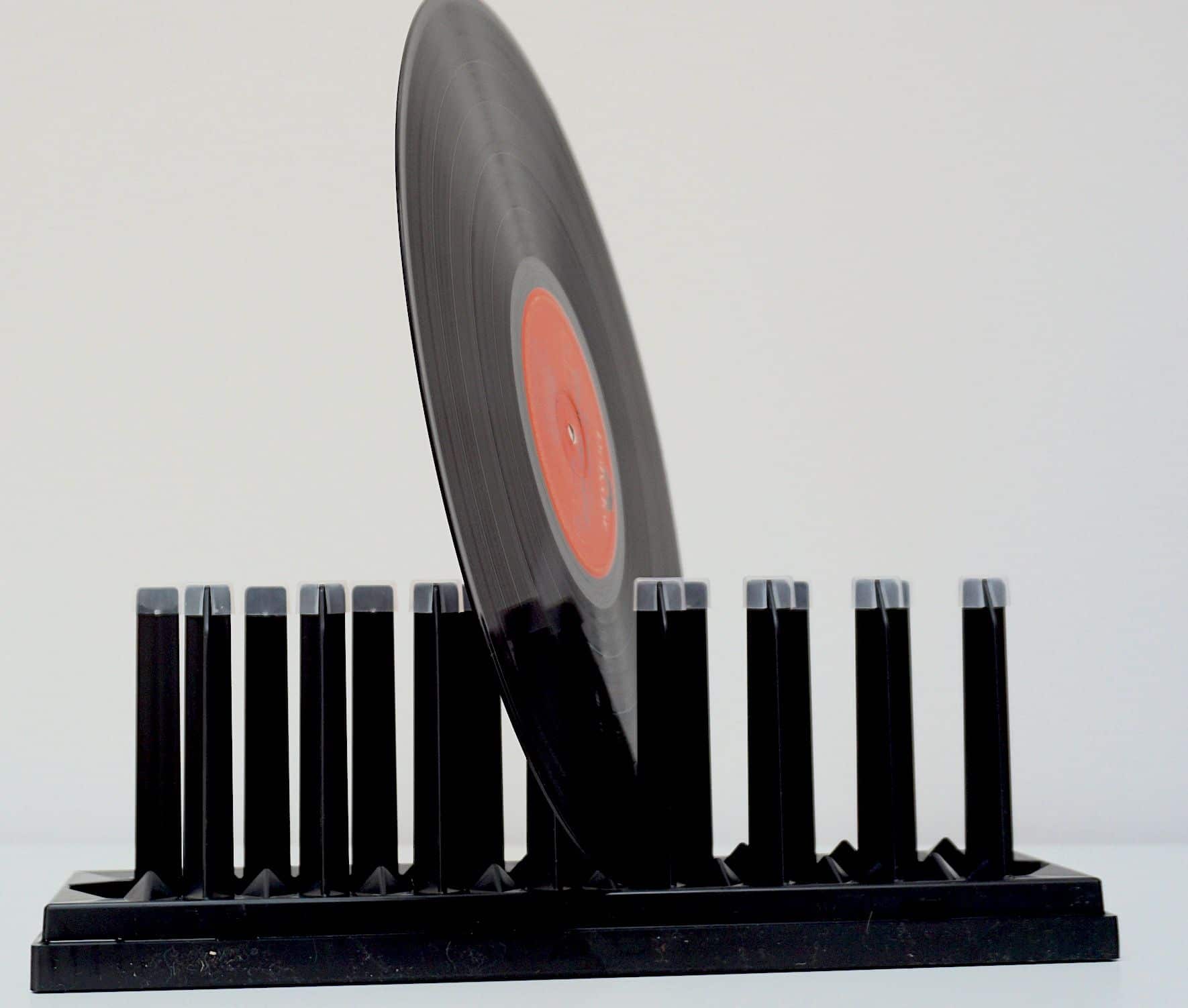
It also indicated that, quite possibly, performance could be improved still by the Disco-Antistat machine if a replacement formula could be used instead.
This is why I flew in my go-to bath liquid. A simple affair that I utilise when cleaning liquid in an ultrasonic cleaner, I use it in my ultrasonic cleaner’s bath. That is, pure distilled water plus 7% isopropyl alcohol.
I firstly cleaned the Disco-Antistat bath with distilled water and repeated the sonic tests. The results? No residue! Hurrah!

The sound also showed an increase in imagery around the central stereo image plus enhanced bass performance. Not excessively but enough to provide a better tonal balance. So the vocal now had a slight extra weight which gave the lead singer’s voice more structure and body. Bass guitar was prominent in the mix, allowing the ear to easily track it throughout while percussion had heft and power now. Even the vocal harmonies had a sense of chocolate smoothness that was missing earlier.
The extremes of the upper mids offered a touch of extra insight. Cymbal taps sounded like symbol taps and less like a snake hissing in the rear of the mix. That said, there was a fly in the ointment, a touch of hardness at times in the upper mids.
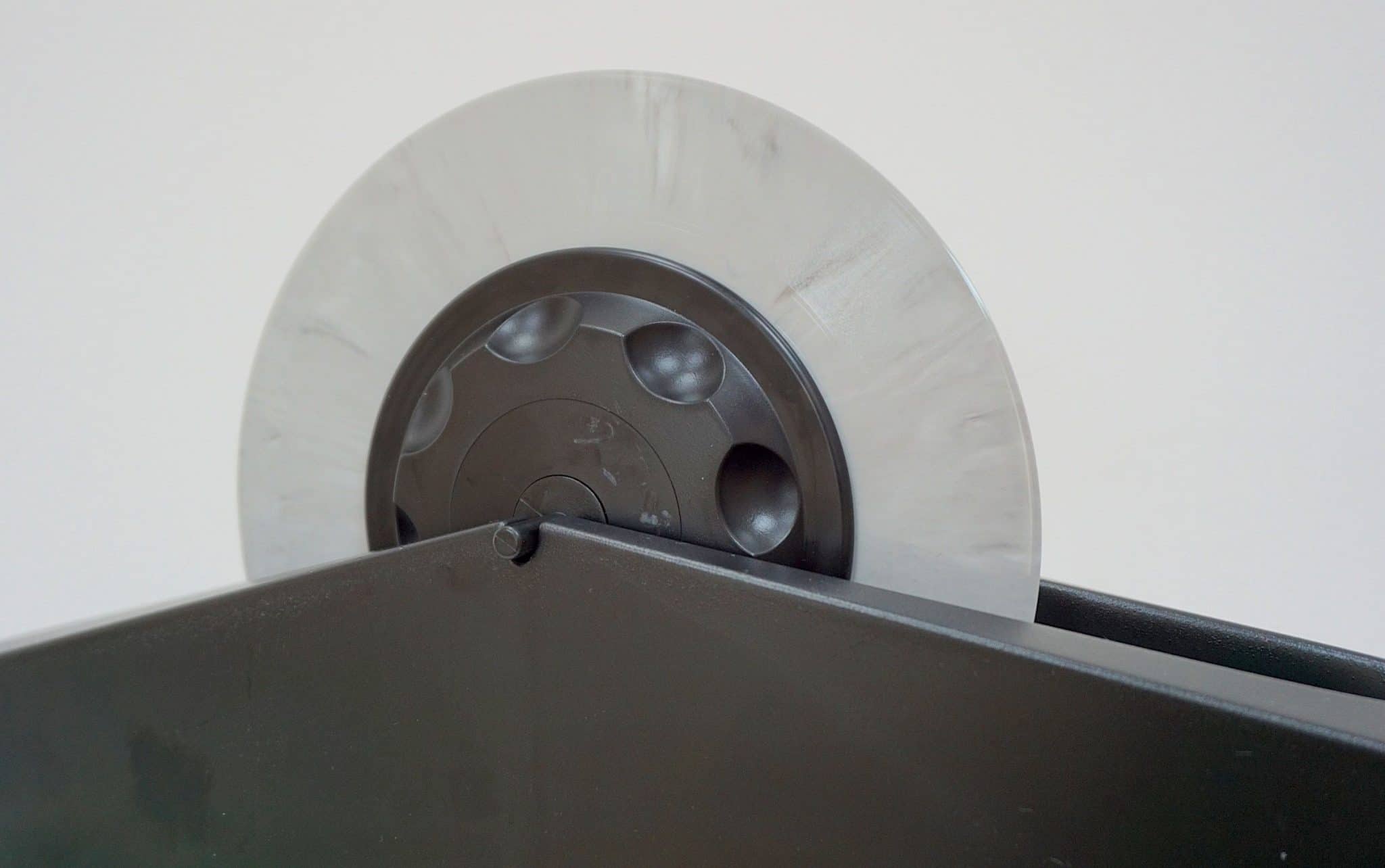
Nevertheless, I wanted to see if I could address that and possibly enhance the sound still further by bringing in my favourite surfactant combo. A mixture of distilled water, Glycol and Tergikleen (a Tergitol concentrate diluted into the water). I applied the solution directly to the disc with a Kabuki brush and pipette and spent a few moments pushing the surfactant deep into the grooves to remove any possible surface tension and to increase the cleaning effectiveness. The bath liquid remained the earlier alcohol/distilled water mix.
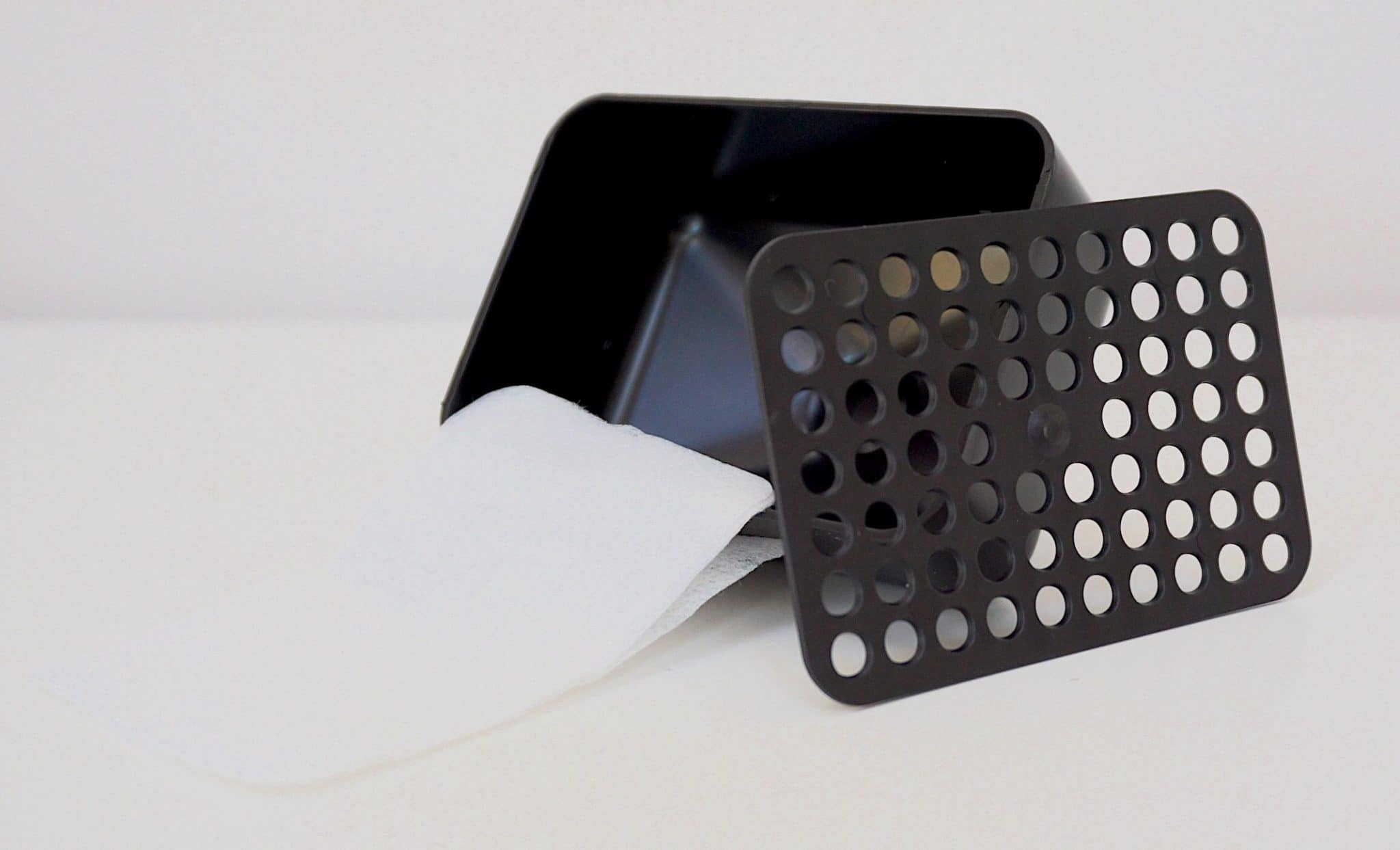
The sonic results were, for a manual cleaning machine, quite breathtaking. The sheer complexity of the information now on offer was absolutely magnificent. It was the delightful combination of dynamic reach and detail that was, at least initially, overwhelming. My ears darted here and there in an attempt to take it all in.
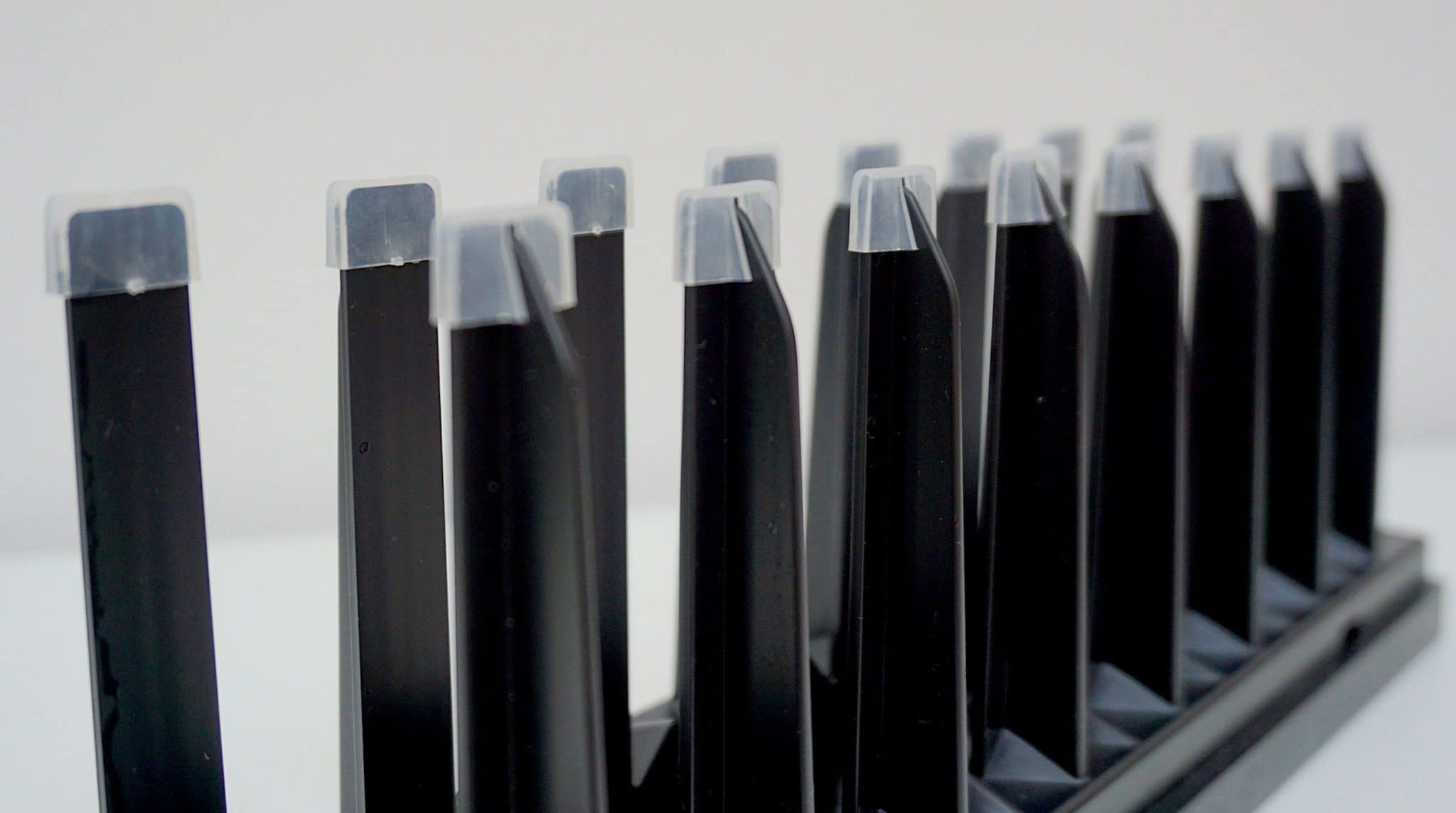
The lead vocal now had nuance and emotive intricacy instead of the earlier one-dimensional monolith that I was hearing before. The backing harmonies were packed with texture and a layered delivery. Percussion was tonally balanced and organic with it but retained power, guitars offered a weight in resonance terms but also a beautiful midrange insight and…well, I could go on for three sides of A4. I really could.
Oh and before I ended? I grabbed two old, pretty ragged records: one from Peggy Lee and another from James Taylor. Both exhibited cracks and pops during play and both needed some TLC. Both received it from the Disco-Antistat too. Cracks and pops reduced dramatically after the cleaning process. The play wasn’t completely silent sure but I noticed a second clean improved matters further and additional cleans would surely improve the sound down the line while I wondered if a few of those pops may very well have been the result of vinyl damage. Neither of my records – brought in from car boot purchases for the sake of this test – were in great condition. Physical damage is something no vinyl cleaner can fix. Still, the differences were stark and welcome after treatment.
And let me add now, the final rating I will apply is for the machine itself, not the liquid. I see the liquid as a bonus extra only. And you should see it that way too.
CONCLUSION
Easy to assemble and use, sturdy and strong in terms of build but with an affordable price to boot, the Disco Anstistat might not arrive with the perfect cleaning liquid but everything else about this vinyl cleaner is about as near to perfect as you’re going to get for the asking price.
Once you sort the correct preparation and cleaning liquid, the amount of information reaching the ear is impressive indeed. Giving the music you listen to an incredible maturity. If you do grab a sample, it will reward you with a quite stunning cleaning and sonic performance. I see the Disco-Antistat as the market leader in manual vinyl cleaning and, because of that, I’m giving it a rare full marks rating and a Golden Groovy award.
KNOSTI DISCO-ANTISTAT VINYL RECORD CLEANER
Price: £46.50
Website: www.tonar.eu
TO BUY CLICK BELOW:
EUROPE – https://amzn.to/2HXyDpS
GOOD: sonic performance, build, ease of use, feature set, cleaning brushes
BAD: bundled cleaning liquid, instructions
RATING: 10
TO BUY, CLICK BELOW:
FOR THE UK: https://amzn.to/3dyJH8I
FOR EUROPE: https://amzn.to/31dRBQ9
FOR THE USA CLICK: https://ebay.to/3bLMvi2
[Don’t forget to check out my new Patreon Page at www.patreon.com/audiophileman, for exclusive postings, giveaways and more!]
REFERENCE
Origin Live Sovereign turntable
Origin Live Enterprise 12″ arm
Icon PS3 phono amplifier
Aesthetix Calypso pre-amp
Icon Audio MB845 Mk.II Monoblock Amplifiers
Quad ESL-57 Speakers with One Thing mod
Audio-Technica AT-LP140XP turntable
Blue Horizon Professional Rack System
Harmonic Resolution Systems Noise Reduction Components
Gutwire Consummate Grounding Cable
Air Audio AC-2K Balanced Transformer
All vinyl was cleaned using an Audio Desk’s Ultrasonic Pro Vinyl Cleaner

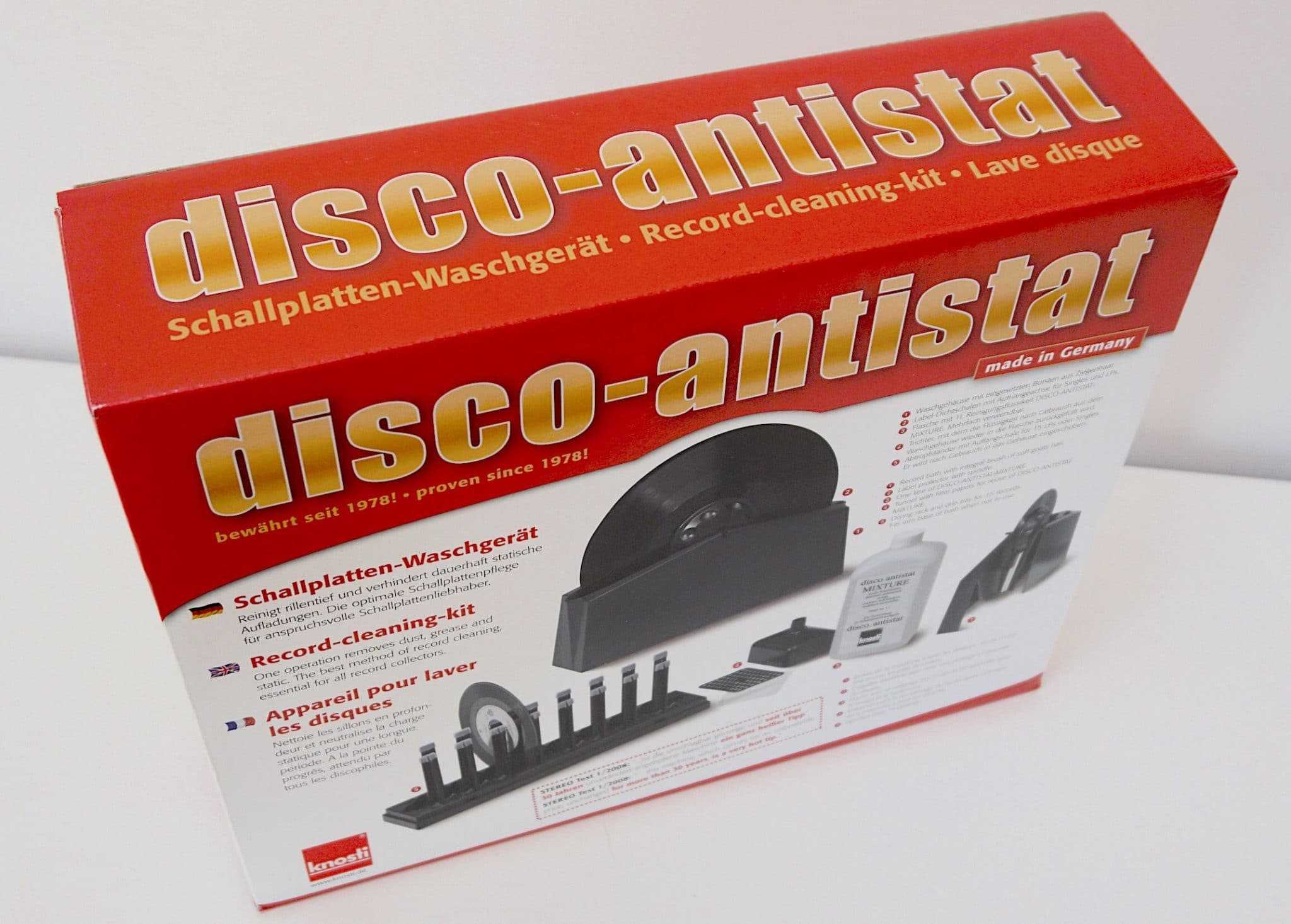
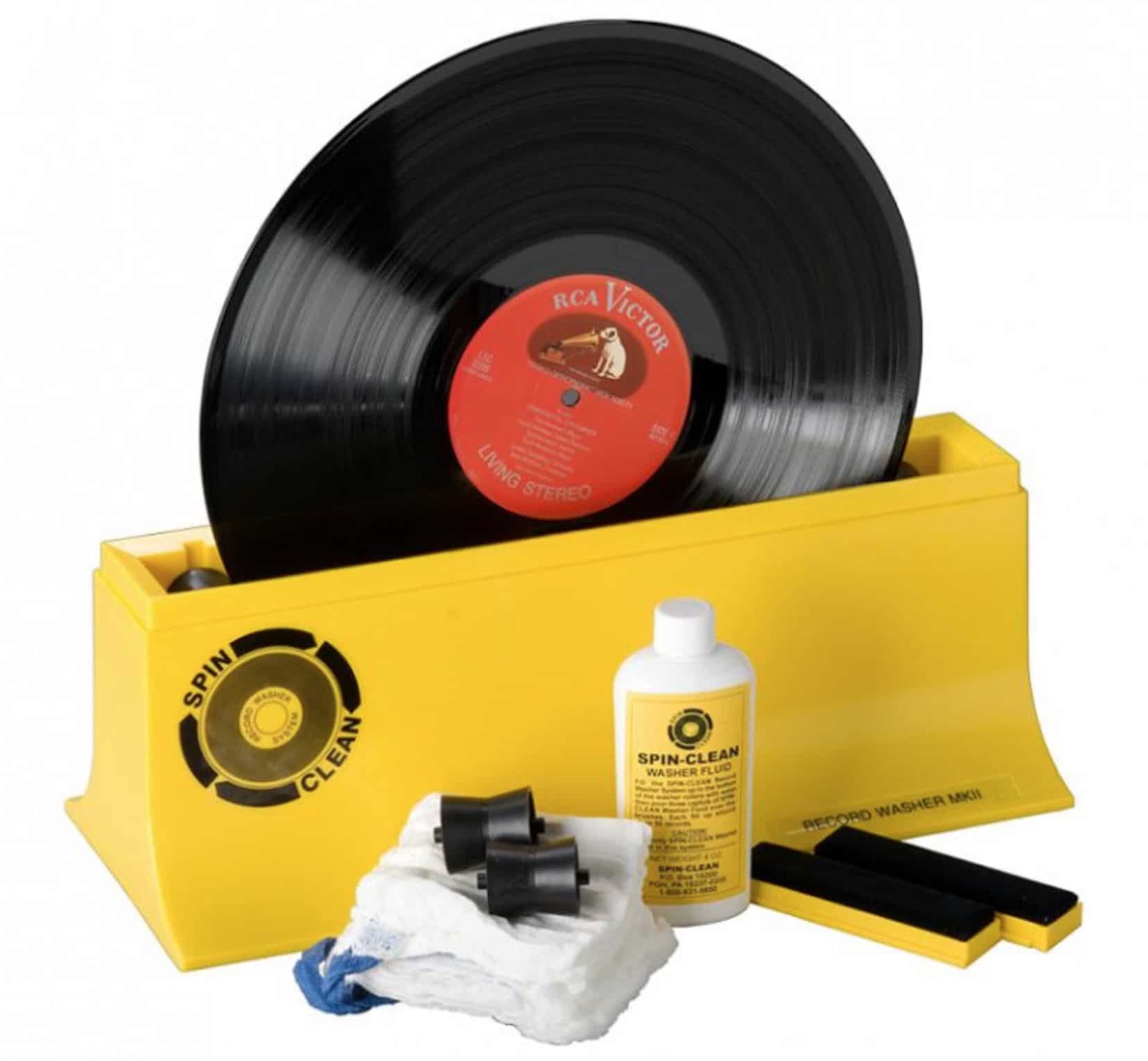
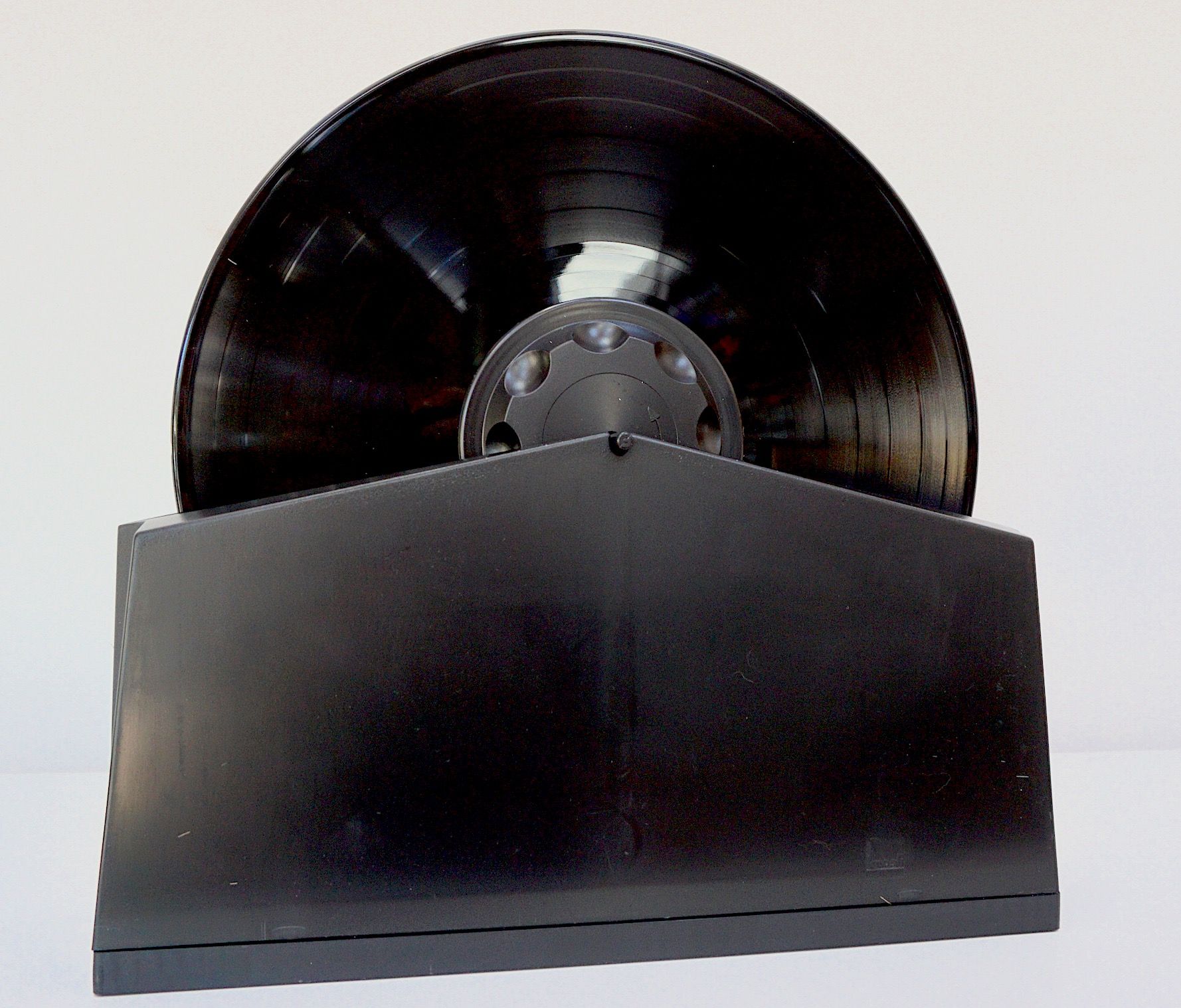
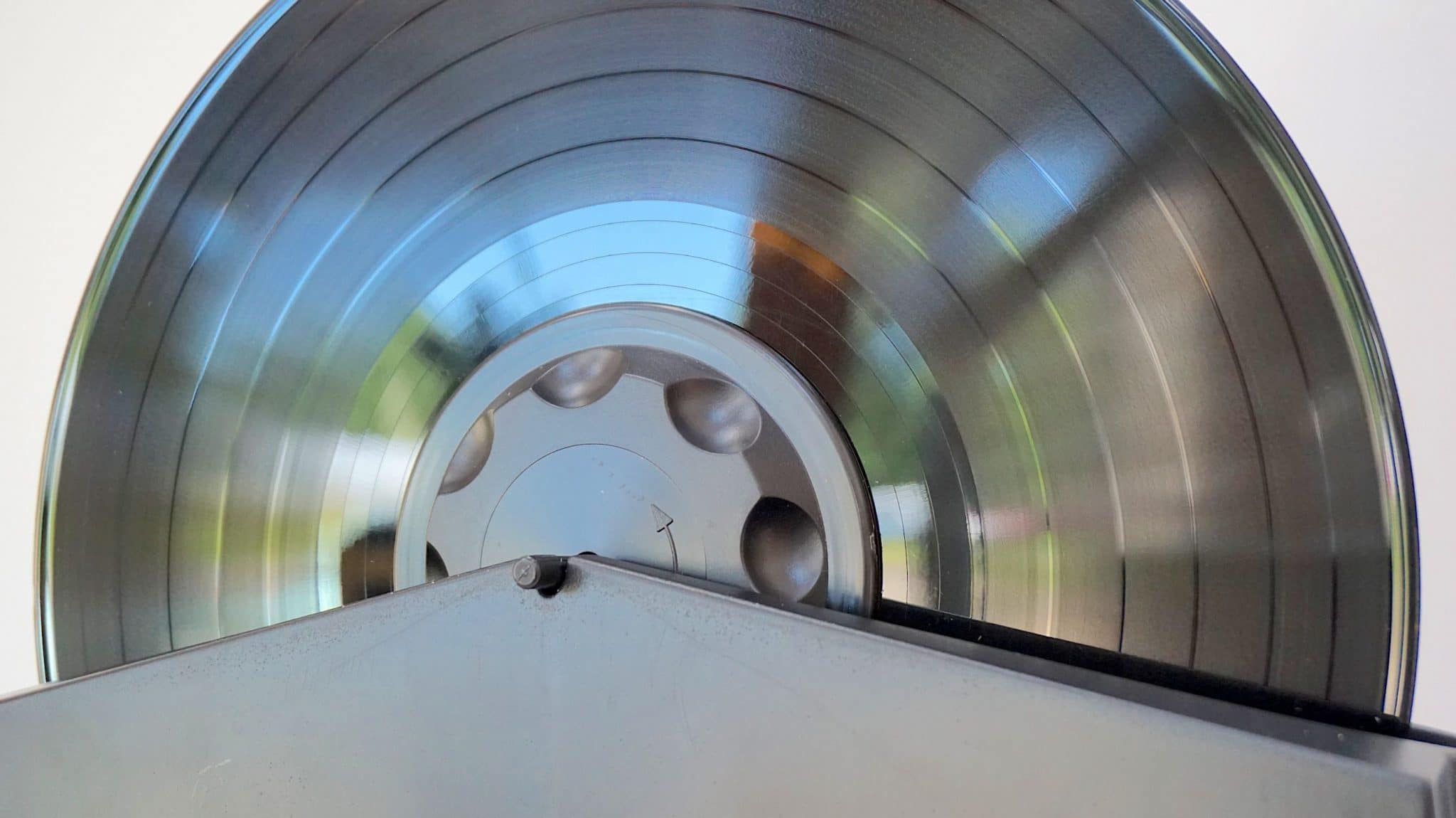
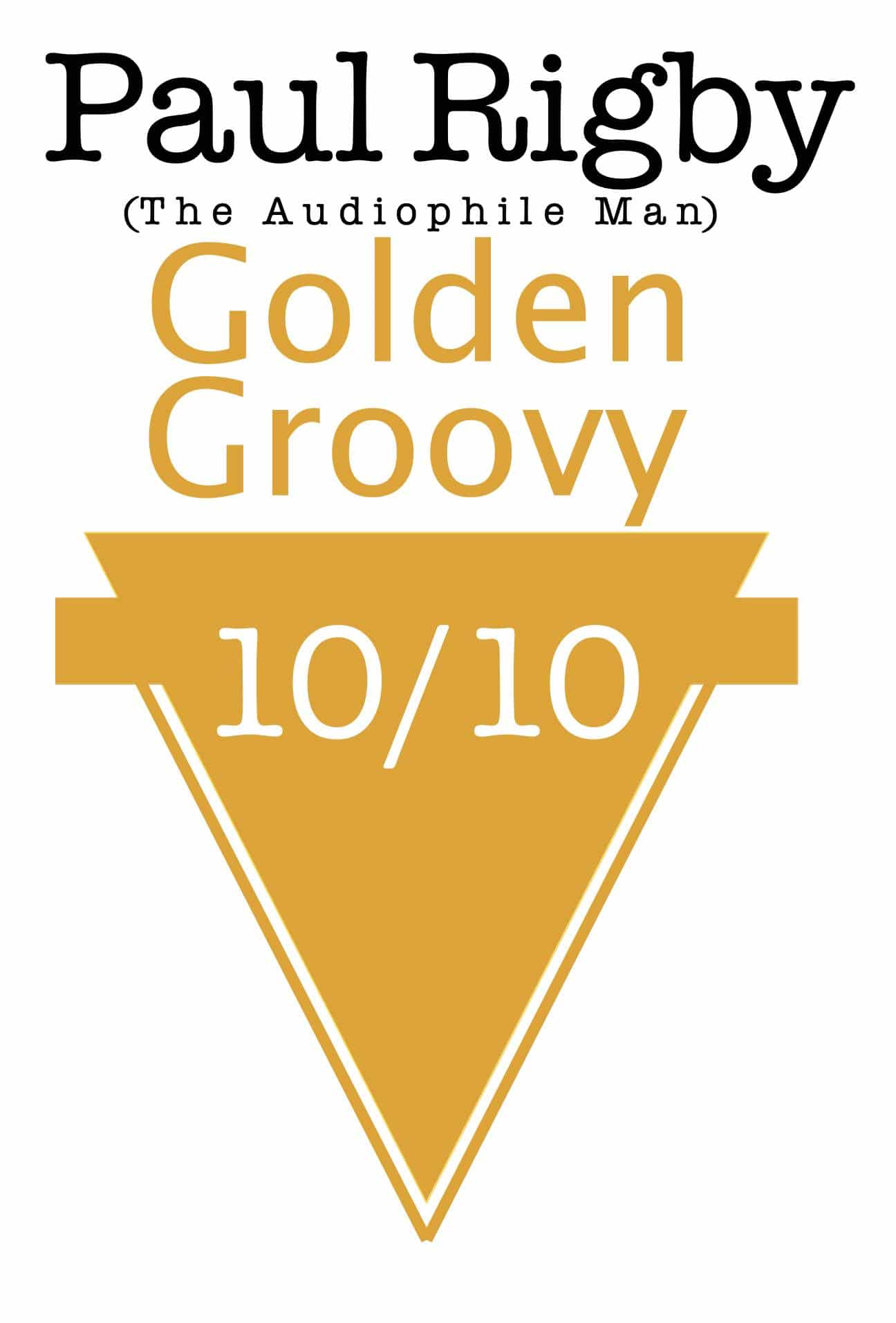


Hi Paul, up to recently I used one of these manual cleaners with Ilfotol surfactant before using a 7% isopropyl/distilled water mix in the reservoir and I found the results mixed. I don’t know whether whilst drying they picked up dirt but many of my records still had pops and crackles which were infuriating despite a number of cleaning cycles. My ears are not a sensitive as yours so I never hear the other sonic benefits you can. I have now moved to a Pro-Ject vacuum RCM and the results are night and day. No more pops, crackles etc. just silent records. I appreciate there is a big price difference but for me the benefits were worth it.
Hi Richard – I’m working on a surfactant feature as I type this so watch out for that. It may help. Also, I wouldn’t put the Ilfotol in the bath. It needs to be applied to the vinyl surface, otherwise you dilute its beneficial effects. You need to add Glycol too to keep it in place (gravity acts upon it otherwise). Again, I plan to publish a manual cleaning guide in the near future to explain this too. That said, RCMs are excellent so I’m happy that you’ve found a solution.
Hello Paul,
I‚Äôve read your articles and seen your videos, some of them more than once. I think you‚Äôre on the right track. One answer I haven‚Äôt found, though: Just how much better is an ultrasonic cleaner than a Disco Antistat? The only hint of a preference that I’ve found is that the Antistat is excellent “for a manual cleaner.” I know that there‚Äôs a point of diminishing returns in hi-fi buying, and I don‚Äôt want to spend money on a cleaner just because it‚Äôs more expensive. If it does a significantly better job, though–well, that‚Äôs different. If I do buy an ultrasonic machine, it will be under $1000. If I buy the Disco Antistat, I‚Äôll buy two of them with one for rinsing. One final point: I seriously doubt that my aging ears can hear the nuances that you hear when you’re comparing cleaners or cleaning a record for the sixth time. I’m glad you, and surely others, can hear those nuances, though.
Thanks,
John
Thanks for the question John. I would disagree about “diminishing returns” point in hi-fi. That notion is probably attributed more to a stubborn bottle neck preventing further sonic improvements. Most people hit that point and assume that sound quality has hit an impenetrable ceiling. Not so. Get rid of that and you’re off again 🙂 But back to your point. I would say that an ultrasonic cleaner is far and away the best cleaning technology on the planet at the moment. Far superior to any manual method you care to through at the problem. Within that category, the more expensive units are better still, principally because they’re designed to clean vinyl and not – like the lower cost units – your grandmother’s wedding ring. Nevertheless, even the lower cost units offer excellent performance because the inherent tech is so efficient and removes baked on grime that manual and vacuum technologies cannot shift.
Saying all of that, if you truly believe that you won’t hear any benefits from using a system (and I would talk to a dealer about a home demo to make absolutely sure – home demos are an increasingly common service these days) then sure, go for the best manual cleaner out there, the Disc Antistat. Or two as you say. That will provide a high level of cleaning ‘as is’.
A cheapish solution (no pun intended) to the vinyl cleaning conumdrum.. thanks for this comprehensive review and thoughtful reflections on the cleaning liquid too …
Not a problem – glad you liked the review, Lloyd.
Thanks for the response, Paul. To clarify, by “diminishing returns,” I meant just that: After a certain point, spending huge amounts of money on speakers, for instance, can bring superior results–not hugely superior yet at a great cost. I didn’t mean to imply that there’s a “ceiling.” I have nothing but good wishes for anyone who loves his $xxxxx speakers but wants a little something more and spends $xxxxxx to get it. It’s his or her money. As a retired public servant–and there are lots of folks out there in my general category–I have to wonder how much I’d have to spend to improve on the sound of my speakers, which are excellent and which I thoroughly enjoy. So far, I haven’t felt that spending a lot of money for a little improvement is worth it.
I’m glad to have your ringing endorsement of ultrasonic cleaners vis-√†-vis the manual variety. It’s helping me to a decision. Unfortunately, there is no nearby dealer I can rely on, so I’ll have to count on reviews like yours. You’re doing a service to all us music lovers; please keep at it.
Regards,
John
Did you consider using the Antistat to clean, and the Spin clean to rinse (using distilled water)? Just a thought. I wonder how effective it would be.
I will be going into rinsing with a future manual cleaning guide and I’m looking at a second Antistat for that purpose. I might actually look at the Mk.II Antistat because I think this review needs an update for the latest hardware tweaks out there.
Thanks, Paul. I’ll be looking for it.
Hi Paul,
An interesting review given the device is actually not that new circa 78! So it’s stood the test of time. In your view, in a rough percentage, how much better is an ultrasonic cleaner in terms of sound quality reveal ? Also how does it standup to other semi-auto/auto machines from Loricraft,Moth, Pro-Ject etc.
Regards
Rob
Night and day, Rob – the Antistat is superb, for a manual cleaner. The Degritter ultrasonic cleaner (check out the review on this site) is the best cleaner on the planet…currently. It’s better than the RCMs out there too. As for the RCMs and the Antistat? Well, I have a sneaking suspicion that the best RCM cleaning operation needs a pre-wash with an Antistat to perform at its best. But I aim to test that. The RCM provides that essential vacuum drying action to prevent recontamination.
I think the Disco Antistatic is better than many mechanical cleaners.
…or use this WITH its’ solution for stage 1 and then give to a friend with a degritter to blast off the residue?
Hi Paul, can you buy your preferred cleaning liquid, ie. pure distilled water plus 7% isopropyl alcohol. ready made anywhere?
Maybe I should concoct and sell my own eh, Alan? Could be a business right there! 🙂 Not at the moment but I’ll include the tools and processes in the manual vinyl cleaning feature when I get around to that one.
Be careful with isopropyl alcohol. Some consider it carcinogenic(very controversial health advisors )
Excellent article, thank you. It prompted me to buy a Knosti after many years of indecision!
As the supplied fluid appears to have drawbacks (deposits on the stylus), I would prefer to mix my own. An article on recipes for cleaning fluid would be most welcome. I have distilled water, Tergikleen and IPA all ready to go, but no certain ideas about the proportions.
Glad you liked it Mark and yes, all in the works. I’ll be doing a feature of surfactants first (your Tergikleen will be featured within), then a detailed feature on manual vinyl cleaning will follow. I need to look at the Mk.II version of this machine beforehand. It’s on the way though 🙂
I use two Disco Antistats together, one to clean and one to rinse with deionised water. Vinyl Shelter cleaning fluid which is IPA based. Very pleased with results after cleaning about 1000 LPs.
Yep – I’ll be looking the whole rinsing thing in a later manual cleaning for vinyl feature. Good to hear you’re already doing that Malcolm.
Hi Malcolm, I think of doing the same and having one more Antistat case. How much time shall I wait after cleaning with the Antistat fluid? Shall I wait for the record to dry and then rinsing it with the destilled water or I can rinse with the destilled water right away after I clean with the Antistat?
Cheers,
Lache
Hi Lache
I rinse immediately after cleaning, I have the 2 knostis set up next to each other, I take the record out of the cleanibg bath and let it drain back into the bath then move it to the rinse bath.